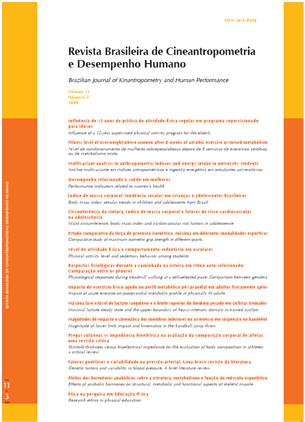Respostas fisiológicas durante a caminhada na esteira em ritmo autosselecionado: comparação entre os gêneros
DOI:
https://doi.org/10.1590/1980-0037.2009v11n3p307Resumo
O objetivo do presente estudo foi comparar o O2Máx, FCMáx, %FCR, % O2R e METs entre os gêneros durante a caminhada em ritmo autosselecionado e verificar se a intensidade selecionada apresenta-se fisiologicamente efetiva para manutenção ou melhora da aptidão cardiorrespiratória (ACR). Participaram 17 homens e 17 mulheres com média de idade de 23,32 ± 3,06 anos, submetidos: (I) avaliação antropométrica e teste incremental máximo em esteira, (II) um teste de 20-minutos de caminhada em ritmo autosselecionado. Na análise estatística, empregou-se um teste t Student para medidas independentes, adotando p < 0,05. Nenhuma diferença significativa entre os gêneros para o %FCMáx (58,38 ± 8,86 para homens e 62,12 ± 5,91 para mulheres), %VO2Máx (37,54 ± 10,75 para homens e 40,34 ± 7,27 para mulheres), %FCR (36,83 ± 11,77 para homens e 38,46 ± 8,33 para mulheres) e % O2R (31,88 ± 11,17 para homens e 34,70 ± 7,74 para mulheres). Entretanto, verifica-se que a velocidade de caminhada (km.h-1) selecionada foi superior no grupo masculino (5,96 ± 0,66; p < 0,001) comparado ao feminino (5,41 ± 0,46), o que, possivelmente, propiciou que os METs fossem maiores nos homens (6,07 ± 1,57, p < 0,05) comparado as mulheres (5,23 ± 0,77). Conclui-se que ambos os gêneros autosselecionam um ritmo de caminhada considerado não efetivo para manutenção e melhora da ACR, contudo, os valores de METs demonstram-se dentro do indicado para manutenção e redução do peso corporal. As diferenças encontradas entre os gêneros para o METs podem ser decorrentes das diferenças apresentadas para a velocidade de caminhada e características antropométricas.
Publicado
Edição
Seção
Licença

Direitos Autorais para artigos publicados nesta revista são do autor, com direitos de primeira publicação para a revista. Em virtude da aparecerem nesta revista de acesso público, os artigos são de uso gratuito, com atribuições próprias, em aplicações educacionais e não-comerciais, desde que seja dada a atribuição. Esta obra foi licenciada com uma Licença Creative Commons Atribuição 4.0 Internacional - CC BY


